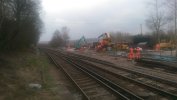how do we define "success"?
Some random thoughts from a non-expert:
Surely it's got to be primarily financial, but even given you just consider that, it's a very difficult question.
In one way it should be straightforward. Take the cost of maintaining the connection, and set it against the revenue and savings it generates.
Take the revenue from charters, or use by NR or rail operators for their purposes (such as the use of the MNR to store rolling stock).
Add the savings from transporting in visiting locos, maintenance plant, ballast etc. by rail instead of road.
Maybe evaluate over a three or five year period and decide whether it's worth keeping.
But in another way, it's impossible to evaluate some of the finances accurately, since we're dealing with an alternate reality. For example, if you had arranged a different event instead of having an incoming charter, would that have been more profitable? For a visiting loco, would you have paid the extra road transport costs for that loco, or for another more local one, or done without? Can you get a "bulk deal" for multiple road transport instances per year?
And then there's the future. You know that the connection is costing more to maintain than the revenue/savings, but you also know (for example) that you're going to have to perform major infrastructure renewals in the near future, involving (let's say) bringing in large quantities of ballast and various rail maintenance plant, and it will potentially more than earn its keep then.
Finally of course there's the unpleasant fact that if a connection is taken out and in particular removed from NR signalling, reinstating it in future is likely to be ruinously expensive. So you have to regard any decision to get rid of it as final, which makes it understandable why some lines cling to connections which may not make any financial sense.
Edit: Of course, the NYMR is a special case with extra, different considerations and so too could be the SR and WSR; the above is meant to apply to railways which do not run onto the national network themselves or have any incoming or potential incoming passenger services apart from charters.
EditL Correct SVR to SR in the above edit.



